








MIDWEEK UPDATE 25 AUGUST 2022Google Banner Ad 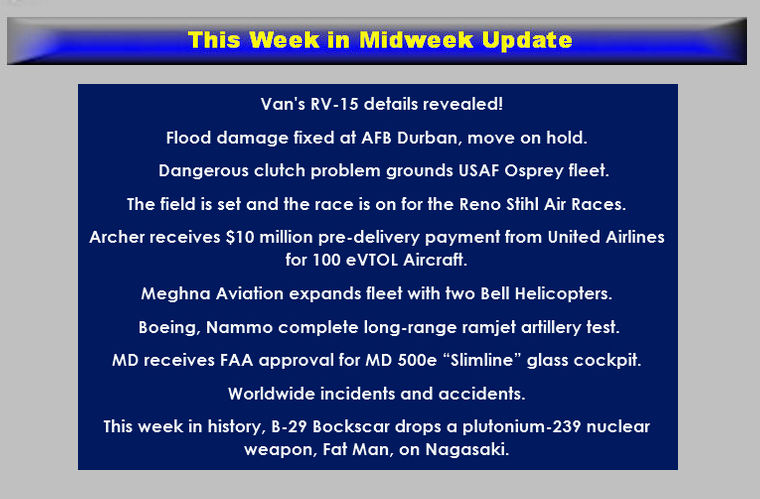      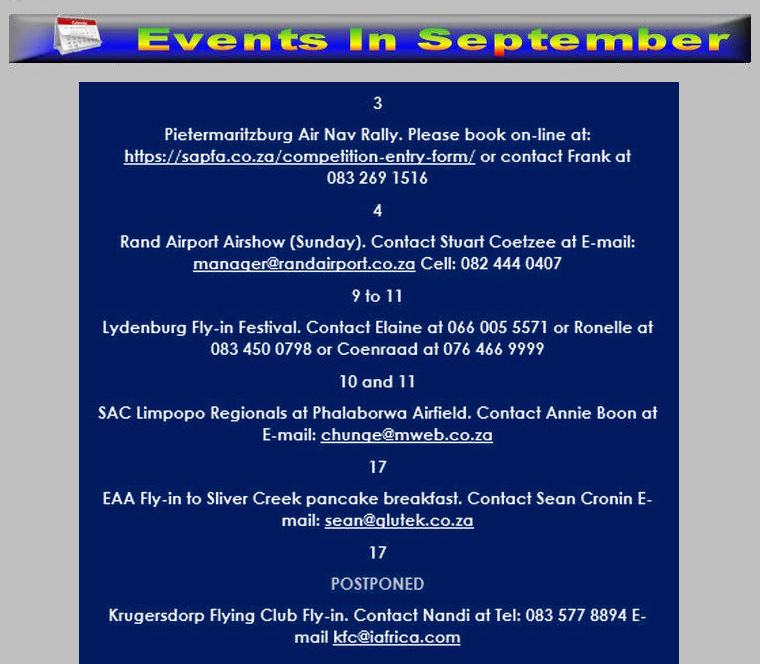 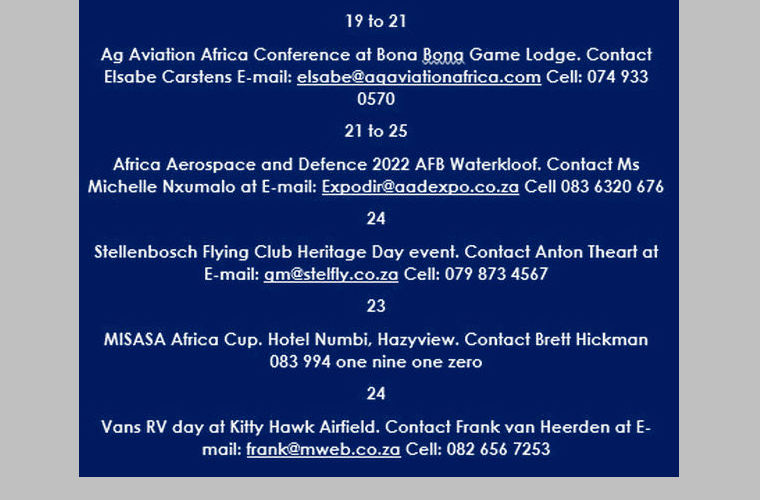      VAN'S RV-15 DETAILS REVEALED   FLOOD DAMAGE FIXED AT AFB DURBAN, MOVE ON HOLD defenceWeb 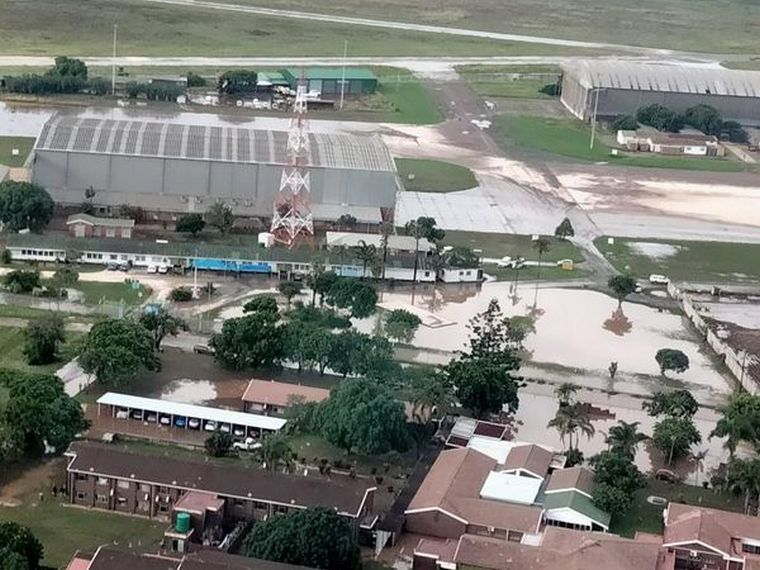 Air Force Base (AFB) Durban is not going anywhere for at least the next five years and any changes or re-alignment of its strategy will for the foreseeable future be built around its current location on what was Durban International Airport. The re-alignment issue was raised by CAF, Lieutenant General Wiseman Mbambo, when visiting the force's only base in KwaZulu-Natal in June during a post-flood inspection. He is reported as saying: "We need to rethink the strategy of this base and align it with the SAAF vision. Quantification, expenditure and time allocation for projects, once again, is necessary to restore the base". The restore part is done according to the Department of Public Works and Infrastructure (DPWI), government's landlord and property manager. "Work done is 100% complete", according to a DWPI update on flood intervention projects in KwaZulu-Natal.  "One of the key sites DPWI had to repair was the Durban Air Force Base. This work is now 100% completed. The work included repairing damaged roofs, floors, walls, downpipes and gutters. Other work completed included replacing generators, repairing blocked sewage drains and removing mud sludge from the hangar room at the base. Scoping for further critical construction work is underway to secure the required funding. This is projected to be completed by the end of August," the DWPI statement has it. AFB Durban is home to 15 Squadron and its mixed Augusta A109 and Oryx fleet along with maintenance and administrative personnel as well as 508 Squadron providing security. The lone SAAF Durban - and KwaZulu-Natal - base remains the only aviation related occupant of what was once the province's international airport. The airport was replaced by King Shaka International north of Durban in time for the 2010 FIFA Soccer World Cup with indications that the Air Force would take up residence at the airport. In 2019 defenceWeb was told preliminary work on establishing a base at King Shaka was underway. This was said to involve an environmental impact assessment and landscaping, understood by this publication to be earthworks associated with civil engineering and construction. The official response at that time was: "The construction timeframe is five years, however, it will be moved to the right with a year due to the lost year as a result of the COVID-19 pandemic. According to the time schedule, the new base is anticipated to be occupied around the end of 2025 to the beginning of 2026 provided no other external factors impede the construction progress". defenceWeb approached King Shaka to ascertain if there is movement on building an Air Force Base at the International Airport. The enquiry was referred to Dube TradePort, the provincial special economic zone operating on land adjacent to the airport property. Dube marketing and communications officer Vincent Zwane said the Air Force "engaged" Dube TradePort "on relocating some of its operations to Dube TradePort land, adjacent to King Shaka International".  DANGEROUS CLUTCH PROBLEM GROUNDS USAF OSPREY FLEET Those two crashes, as well as four other Class A mishaps this year, prompted USAF AFSOC Commander Lt. Gen. Jim Slife to order the stand-down to ensure airmen's safety. AFSOC Public Affairs Director, Lt. Col. Becky Heyse, said that the command's 52 tiltrotor Ospreys were grounded due to recent "hard clutch engagement" incidents. Two such problems have happened in the last six weeks, and there were previously two others that occurred since 2017. Hard clutch engagement occurs when the clutch connecting the propeller's rotor gear box to its engine slips. When this happens, Ospreys are designed to transfer the power load from that engine to the other engine immediately, which would allow it to keep operating if an engine failed. Heyse said AFSOC is not sure whether it is a mechanical, design or software problem causing these hard clutch engagements, and as a result can't put solutions in place to stop it from happening again until the command knows more. It is not yet known how long the Ospreys will be grounded.  In the Biplane class, fans will get to root for Maj. Michael Brewer, a U.S. Air Force Thunderbird who flew on the demonstration team from 2018-2022 as both Thunderbird No 3 and Thunderbird No 4. While performing at the Air Races in 2019 and 2021, Maj. Brewer had the opportunity to experience the unique and exhilarating atmosphere and this year is making his race debut in No. 44, Big Cat. 2022 will also mark the second year of competition for the event's newest racing class, STOL (Short Take-Off and Landing) Drag, with 21 competitors looking to take home the championship in the sport that has become a social media phenomenon.  Fans will see demonstrations by the U.S. Air Force F-22 Raptor, U.S. Navy F/A-18 Super Hornet, U.S. Air Force Heritage Flight, U.S. Navy Legacy Flight, Jim Peitz Aerosports and the GB-1 Gamebird. On the ground fans will get to experience the National Aviation Heritage Invitational, Military Static Display, GRADD-NVBAA STEM Education Discovery Zone, the racing pits where fans can get up close and personal with the pilots, planes and crew, and much more.  Archer Aviation Inc. (NYSE: ACHR) today announced that it has received a $10 million pre-delivery payment from United Airlines for 100 of the company's initial production eVTOL aircraft. The payment represents a watershed moment for the eVTOL industry, validating confidence in the commercialisation of eVTOL aircraft and Archer's leadership. United is making the deposit on 100 of Archer's production aircraft which it agreed to purchase in 2021. Archer recently completed its production aircraft's Preliminary Design Review (PDR) and is now advancing to the next stage of its development and commercialisation efforts. The PDR is a meticulous review of the aircraft design to ensure the program is on track and the design is mature enough to proceed to the next development phase and kick-off of production of long lead time hardware. The PDR lays out all aspects of the aircraft's specifications and manufacturing requirements, necessary pre-conditions for determinations that the design is feasible for regulatory compliance and viable to bring to market. United's decision to place a deposit for 100 of Archer's eVTOL aircraft signals its desire to be one of the first airline operators in the U.S. to bring eVTOL aircraft to the market. The pre-delivery cash deposit continues a trend of strong support by the airline throughout development of its aircraft. Recently, United formed a Joint eVTOL Advisory Committee with Archer, allowing the parties to work more closely on eVTOL maintenance and operational matters. Committee members include Archer's operations and maintenance leadership, as well as leadership from United's maintenance, materials, and engineering groups.  "I am incredibly proud of the entire Archer team as we reach this milestone in our partnership with United Airlines. To receive a cash deposit is validation of Archer's achievements to date, not only with flight testing and product development, but also a great signal of confidence in our roadmap to commercialisation" said Adam Goldstein, Archer's CEO. "We're thankful to United for their continued partnership as we usher in this new era in air travel." "This announcement marks a new important phase in our relationship with Archer, and our commitment to EVTOL technology. We are witnessing an inflection point where consumers, businesses, and policymakers are all aligned to prioritise technology that reduces the impact of climate change," said Michael Leskinen, President of United Airlines Ventures. "United Airlines Ventures has invested in a diverse roster of companies working in support of our goal to reach carbon neutrality by 2050, without the use of traditional carbon offsets. We believe eVTOLs have the potential to both help achieve carbon-neutral travel and serve as an innovative new tool to change how United customers experience comfort, convenience, and efficiency during their commutes within cities across the globe." .jpg) MEGHNA AVIATION EXPANDS FLEET WITH TWO BELL HELICOPTERS  Upon delivery, Meghna's new Bell 505 and Bell 407GXi will increase their Bell helicopter fleet to four aircraft that support the company's corporate, leisure and utility helicopter charter business. "We are honoured by the continued trust that Meghna, a leading Bangladeshi aviation company and long-time Bell customer, has shown in Bell with today's announcement," said Jacinto Monge, Managing Director, Asia Pacific Bell. "I am confident Meghna's new Bell 505 and Bell 407GXi will provide them the flexibility and reliability to expand their mission profiles in Bangladesh." The Bell 407 aircraft has played an essential role in critical missions for more than 25 years. The aircraft sets a high standard for single-engine aircraft with its unmatched reliability and performance in hot, high and maritime environments. There are more than 1,600 Bell 407s globally, logging 6 million flight hours across the fleet and actively performing flight training as well as military, tourism and para-public missions. The Bell 407GXi's Garmin G1000H NXi Flight Deck enhances situational awareness and reduces pilot workload by delivering easy-to-read information at a glance. In February, the Bell 505 achieved 100,000 global fleet hours, and there have been more than 360 Bell 505 global deliveries since 2017. Equipped with the only dual-channel FADEC engine in its class, the Bell 505 is extremely cost-competitive, providing more power in hot and high-altitude environments. Combined with cutting-edge Garmin G1000H NXi avionics and adaptable cabin design, the 505 is ideal for private charters, corporate executives, utilities, public safety, pilot training and more. .jpg) BOEING, NAMMO COMPLETE LONG-RANGE RAMJET ARTILLERY TEST 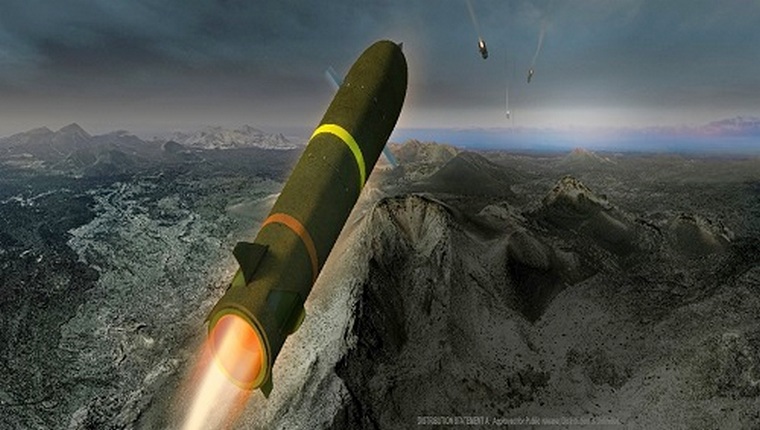 Boeing [NYSE: BA] and Norwegian defence and aerospace company Nammo have successfully test-fired a ramjet-powered artillery projectile, further demonstrating the viability of one of the U.S. Army's modernisation priorities - long-range precision fires. "We believe the Boeing Ramjet 155, with continued technology maturation and testing, can help the U.S. Army meet its long-range precision fires modernisation priorities," said Steve Nordlund, Boeing Phantom Works Vice President and General Manager. "This successful test is evidence that we are making great progress." "This is a historic moment for Nammo," said Nammo Chief Executive Officer Morten Brandtzæg. "The test results demonstrate that ramjets are viable and can fundamentally change the future of artillery". "We have great confidence in the ramjet concept," Brandtzæg added. "The test - with all aspects from cannon firing, to the projectile body, fins, and trajectory all functioning perfectly - represents a real technological breakthrough in artillery, and a major success for Boeing, Nammo, and the U.S. Army." The long-range test at Andøya follows years of research, development and testing by Boeing and Nammo of ramjet technology, including more than 450 static or short-range tests. Boeing Phantom Works and Nammo have been working together under a strategic partnership to jointly develop and produce the next generation of boosted artillery projectiles. In July 2019, the Boeing-Nammo team was awarded a contract under the U.S. Army's XM1155 program to develop and mature the Ramjet 155 projectile. In May 2021, the team was awarded a Phase II technology development contract. Ramjet 155 uses an engine in which the air drawn in for combustion is compressed solely by the forward motion of the projectile at supersonic speeds. Considered a hybrid between guided artillery and missiles, the program has an objective of a common round design that can be used in L39 and L58 cannons. The team continues to develop and mature the technology, with further testing and demonstrations planned in the coming months.  MD Helicopters, Inc. (MDHI) announced that the company has received Federal Aviation Administration (FAA) certification to install a new "slimline" advanced glass cockpit that modernises the MD500E platform for increased visibility and field of view. 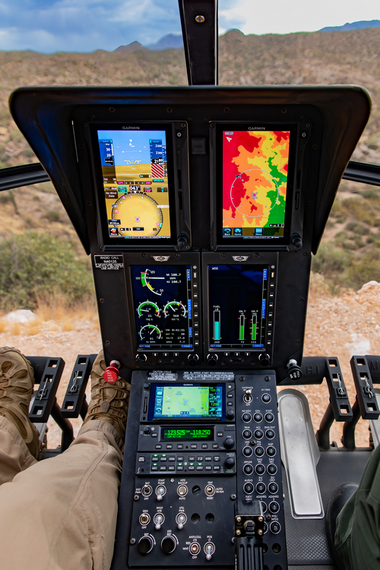 "We have put considerable effort into listening to our customers these past two years; increasing visibility and field of view, and modernisation of the cockpit was a common request," says Jason Lindauer, Vice President Business Development and Aftermarket. "The slimline configuration received significant positive feedback at HAI HELI-EXPO 2022, from every category of operator." The company will be installing the slimline glass cockpit into their training aircraft, providing the most current training opportunities for every operator.   On 15 August an Ethiopian Airlines 787-8 Dreamliner ET-ARF overflew the airport at Addis Ababa after both the pilots had, during the cruise portion of the flight, fallen asleep. The autopilot followed the approach route to the airport but remained at flight level 370. Air Traffic Control during the cruise portion attempted to reach the pilots multiple times with no success. The aircraft followed the pre-programmed route and began flying the approach procedure for runway 25L at ADD. It held its altitude at Flight level 370 throughout the approach. Eventually, the autopilot disconnected, and the disconnect alarm woke the pilots. The pilots safely landed on runway 25L roughly 25 minutes after overflying the airport. All passengers and crew members were safe. The airline has yet to make any official comments regarding the incident. Fatigue most likely caused the pilots to fall asleep and overfly the airport. The inherent nature of flying long trips causes fatigue. Pilots are subject to high fatigue levels while working long days away from home for multiple days at a time. This has been a problem in commercial aviation since its inception. Numerous aircraft accidents and incidents have been the result of pilot fatigue.  USA, Hanna City, IL: A Mooney M20K 231 was substantially damaged when it was involved in an accident in Downtown Hanna City, Illinois. The aircraft had departed from Santa Fe Airport (KSAF) in New Mexico, and was in the air for about 5 hours. The pilot reported an engine out while on approach to PIA stating 10 gallons of fuel remaining. The pilot then reported unable to make the runway and with a highway (Illinois Route 116) in sight below decided to attempt a landing. Video captured by a person inside a parked vehicle showed the aircraft landing on Route 116, making it safely to the ground, during the landing rollout, the pilot attempted to avoid a vehicle on the road, causing the aircraft to veer left and impact the corner of a commercial structure. The aircraft came to rest upright on the opposite direction of travel, and sustained extensive impact damage to the front section. The two people onboard were fatally injured.  USA, Corona Municipal Airport, Corona, CA: An experimentally built Bensen B-8M Gyrocopter sustained substantial damage when it impacted dirt road terrain while on approach to land on Runway 25 at Corona Municipal Airport (KAJO), Corona, California. The sole pilot onboard received minor injuries. USA, IH-8 at Greenfield Dr, El Cajon, CA: A Cessna 195 Businessliner sustained substantial damage during a forced landing on Freeway 8 in El Cajon, California. The sole pilot onboard received serious injuries.  USA, Baton Rouge Metropolitan Airport, LA: A Beechcraft F33A Bonanza with two occupants following a loss of engine power sustained substantial damage subsequent to an impact with terrain during the attempted return to the point of departure near Baton Rouge Metropolitan Airport (BTR/KBTR), Louisiana. The pilot and instructor were not injured. USA, Watsonville Municipal Airport, CA: A ALM Holding LLC Cessna 340A with two on board was on final approach for runway 20 and crashed on the runway and slid into a hangar, killing both occupants. A Cessna 152 was on left base for runway 20 at the same time when the collision occurred. The 152 crashed near the runway 20 threshold and came to rest inverted killing the single occupant.  USA, Yuma Proving Ground, AZ: An U.S. Space & Défense Airbus Zephyr 8 solar powered drone was lost during a test flight. According to a statement made by Airbus U.S. Space & Defence: "Following 64 days of stratospheric flight and the completion of numerous mission objectives, Zephyr experienced circumstances that ended its current flight". ADS-B data shows the aircraft was flying at an altitude of around 52000 feet until it began to descend around 04:52 UTC (21:52 local time, 18th August). USA, Flying Circus Aerodrome (3VA3), Warrenton, VA: A Boeing A75N1 (PT-17) Kaydet was attempting to land when another Boeing A75N1 (PT-17) Kaydet was trying to take off. The two aircraft collided, which caused one of them (N52652) to overturn at Flying Circus Aerodrome (3VA3), Warrenton, Virginia. All four occupants, two in each aircraft, received minor injuries and both aircraft received substantial damage.    9 AUGUST 1945 B-29 Bockscar drops a plutonium-239 nuclear weapon, Fat Man, on Nagasaki Bockscar was used in 13 training and practice missions from Tinian, and three combat missions in which it dropped pumpkin bombs on industrial targets in Japan. On 9 August 1945, Bockscar, piloted by the 393d Bombardment Squadron's Commander, Major Charles W. Sweeney, dropped the "Fat Man" nuclear bomb with a blast yield equivalent to 21 kilotons of TNT over the city of Nagasaki. About 44% of the city was destroyed; 35,000 people were killed and 60,000 injured. After the war, Bockscar returned to the United States in November 1945. In September 1946, it was given to the National Museum of the United States Air Force at Wright-Patterson Air Force Base, Ohio. The aircraft was flown to the museum on 26 September 1961, and its original markings were restored (nose art was added after the mission). Bockscar is now on permanent display at the National Museum of the United States Air Force, Dayton, Ohio, next to a replica of a Fat Man. Google Banner Ad  |
                         |
 |
 |

Copyright © Pilot's Post PTY Ltd
The information, views and opinions by the authors contributing to Pilot's Post are not necessarily those of the editor or other writers at Pilot's Post.